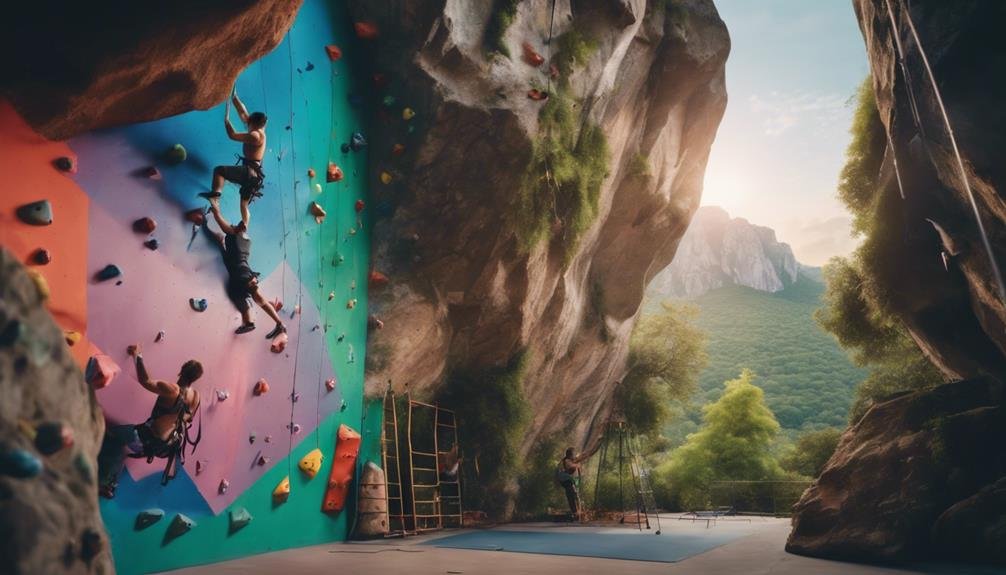
Indoor climbing gyms and outdoor climbing both have their perks, and choosing between them really depends on what I'm after. In the gym, I love the controlled environment and the chance to refine my techniques without weather issues. It's social and supportive, perfect for honing skills. But outdoor climbing calls to me with its breathtaking views and thrilling unpredictability. The connection to nature is unmatched, though it comes with its own risks and logistical challenges. Balancing these factors shapes my climbing journey. If I think about my goals and preferences, I can find the best fit for my adventures ahead.
Key Takeaways
- Indoor climbing offers a controlled environment for skill development, while outdoor climbing provides unique challenges and adaptability to natural terrains.
- The social atmosphere of indoor gyms fosters camaraderie, whereas outdoor climbing promotes connection with nature and adventure.
- Weather conditions can impact outdoor climbing opportunities, while indoor gyms provide consistent access regardless of external factors.
- Indoor climbing features marked routes for structured skill progression, while outdoor climbing allows for diverse experiences with each unique location.
Overview of Indoor Climbing
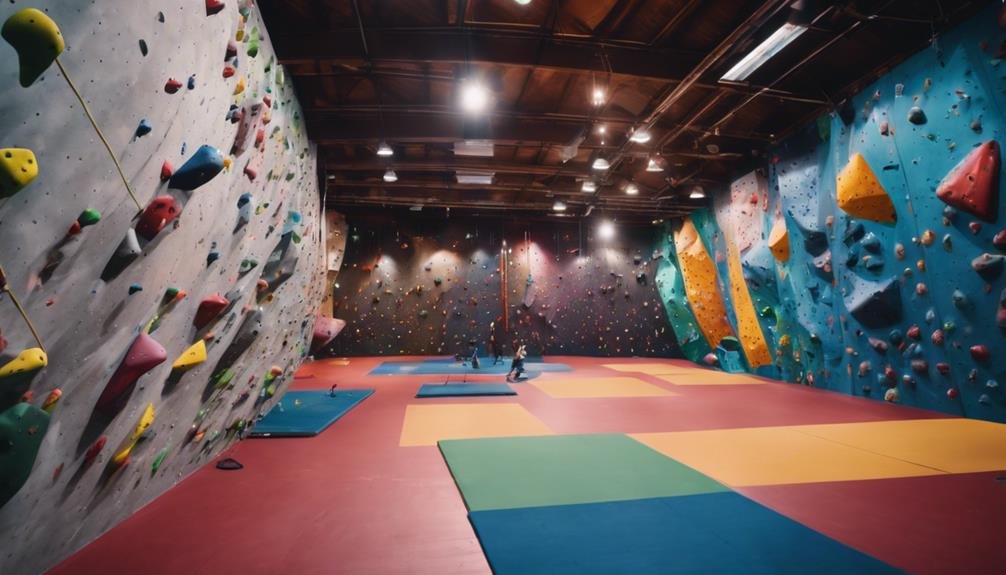
Indoor climbing offers a controlled environment where I can push my limits and hone my skills, all while enjoying the convenience of a temperature-regulated space.
From vertical walls to overhangs and bouldering problems, each climb presents a unique puzzle, allowing me to experiment with different techniques and strategies.
In an indoor climbing gym, I find a variety of climbing terrain features that mimic the challenges of outdoor rock faces.
Spacious climbing areas, padded flooring for safety, and adjustable holds mean I can customize my training. I often take advantage of the expert instruction available, which not only helps me refine my technique but also introduces me to new climbing styles.
The vibrant community of fellow climbers I connect with adds to the thrill, and I appreciate the camaraderie that develops as we share tips and celebrate each other's achievements.
I love that I can climb regardless of the weather outside, whether it's pouring rain or blistering heat. Indoor climbing truly provides a perfect blend of challenge, growth, and freedom in a safe, supportive environment.
Advantages of Indoor Climbing

Climbing in a gym offers me the perfect opportunity to tackle diverse routes without the unpredictability of weather or natural obstacles. I can focus solely on my climbing techniques, as the controlled environment allows me to push my limits without worrying about rain, wind, or rocky terrain.
One of the most appealing aspects of indoor climbing is the social atmosphere. I find it invigorating to connect with fellow climbers, sharing tips and encouraging each other as we navigate various challenges. The camaraderie created in these spaces fosters a sense of community that enhances my overall experience.
Indoor climbing provides a structured approach to skill progression. With clearly marked routes of varying difficulty, I can easily set personal goals and track my improvements. I love how I can work on specific techniques, whether it's mastering foot placements or developing my grip strength, all while enjoying the supportive environment around me.
Ultimately, indoor climbing gives me the freedom to explore my potential, connect with others, and refine my skills—all while keeping the adventure within reach, regardless of what's happening outside.
Disadvantages of Indoor Climbing
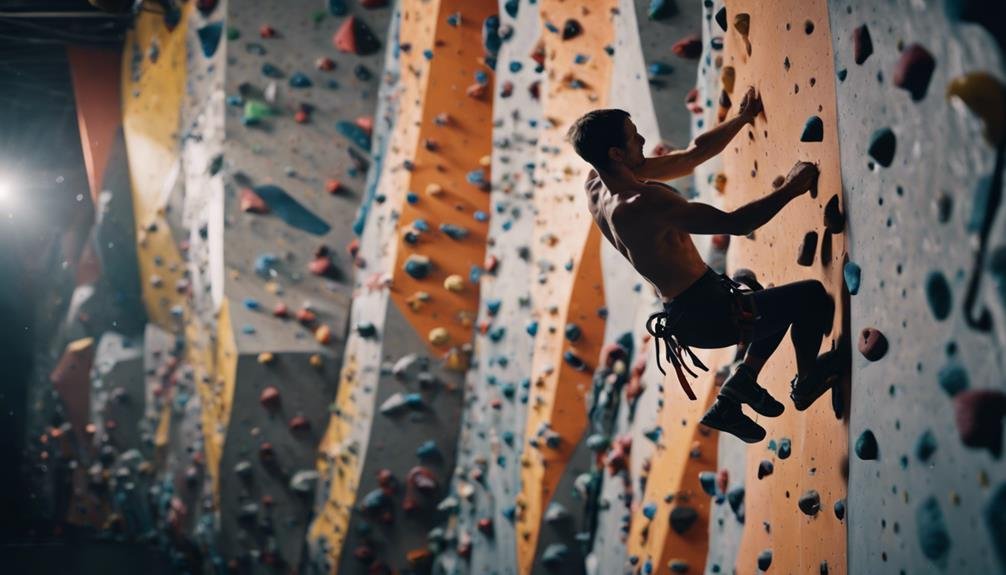
While I enjoy the convenience of climbing indoors, I often find myself missing the raw, exhilarating experience that comes with scaling natural rock faces. Indoor climbing gyms offer a controlled environment, but they come with significant disadvantages. Space constraints limit the variety of climbs, making it harder to challenge myself.
Here's a table to illustrate some key drawbacks:
| Disadvantage | Impact |
|---|---|
| Limited Terrain | Reduces opportunities for varied techniques |
| Predictable Routes | Lacks the spontaneity of outdoor climbing |
| Artificial Environment | Doesn't replicate the natural elements like wind and sun |
These factors can make indoor climbing feel repetitive and less fulfilling. I crave the unpredictability of nature, where each climb is unique and offers a new adventure. The artificial holds and routes, while fun, can't compete with the thrill of conquering a towering cliff. Ultimately, while indoor climbing is a great way to stay fit, it can't replicate the freedom and excitement of climbing outdoors.
Overview of Outdoor Climbing
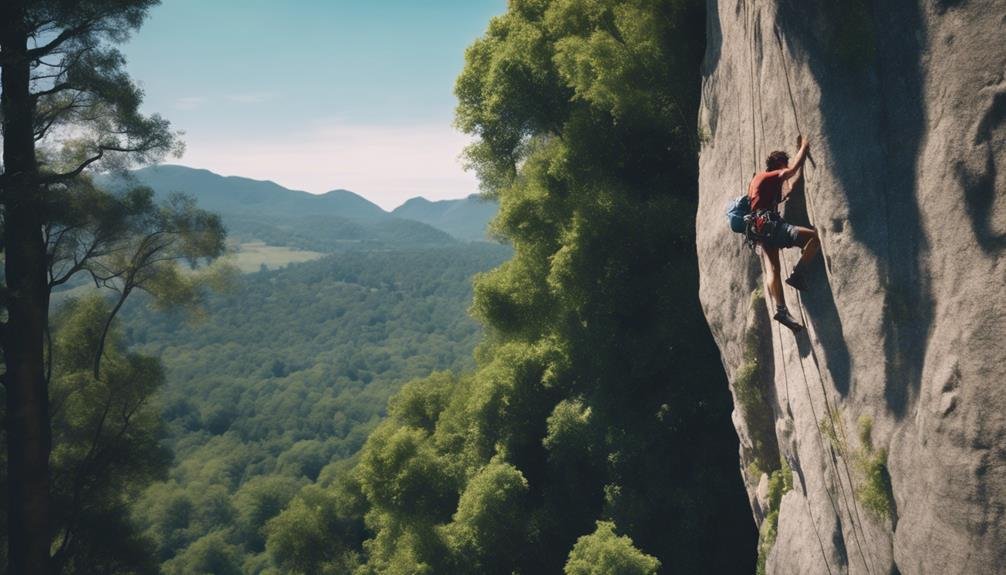
There's nothing quite like the thrill of scaling a rugged rock face, where every hold feels alive and each ascent offers a unique challenge shaped by nature itself. Outdoor climbing isn't just a sport; it's a dance with the elements, a chance to immerse myself in beautiful landscapes that stretch as far as the eye can see. Each climb becomes a journey, filled with moments that ignite my spirit and fuel my desire for thrill-seeking adventures.
When I think about outdoor climbing, I envision:
- Majestic cliffs that rise dramatically against the sky
- The sun casting shadows that dance on the rock surface
- The sound of wind rustling through trees, a natural soundtrack to my ascent
These experiences remind me that climbing isn't just about reaching the top; it's about embracing the freedom of the great outdoors. With every ascent, I'm reminded of the raw beauty of nature, the adrenaline coursing through my veins, and the satisfaction that comes from conquering the unknown. Outdoor climbing is where I truly come alive.
Advantages of Outdoor Climbing
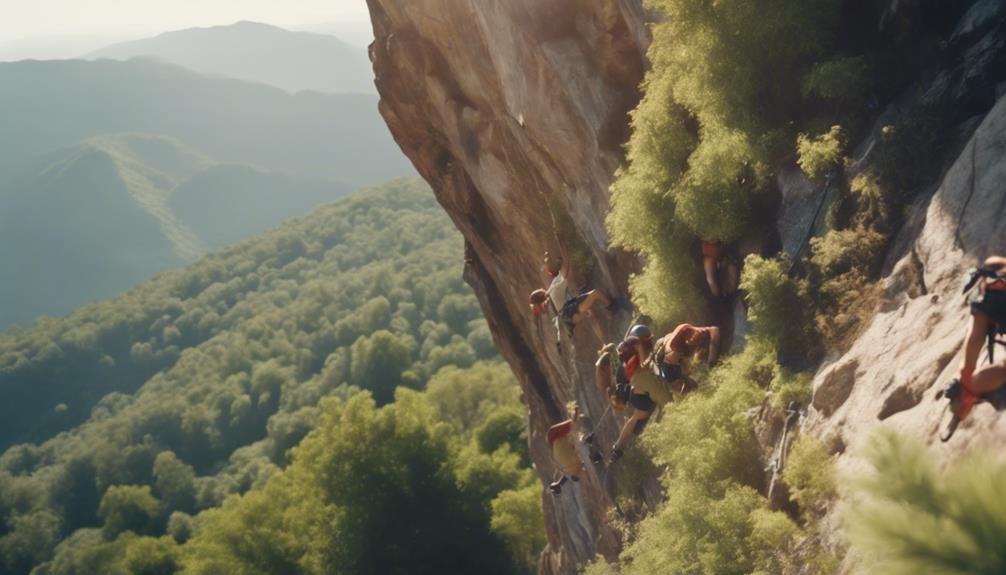
The advantages of outdoor climbing are as varied as the landscapes I explore, offering not just physical challenges but also profound connections to nature and the thrill of adventure.
Climbing on rugged terrain challenges me in ways that indoor walls can't replicate. Each rock face demands my full attention and adaptability, pushing my limits while enhancing my problem-solving skills.
As I scale cliffs under the vast sky, I can't help but appreciate the natural environment around me. The fresh air fills my lungs, and the sounds of nature become my soundtrack. I feel a deep sense of freedom, far removed from the confines of indoor gyms.
Outdoor climbing immerses me in a beautiful tapestry of sights, from majestic mountains to serene forests. Each ascent offers a unique experience, often leading to breathtaking views that reward my efforts.
The camaraderie I share with fellow climbers, united by our love for the wild, enhances the adventure even more. Ultimately, outdoor climbing satisfies my craving for exploration, adventure, and a genuine connection to the earth, making it an unparalleled experience in my climbing journey.
Disadvantages of Outdoor Climbing
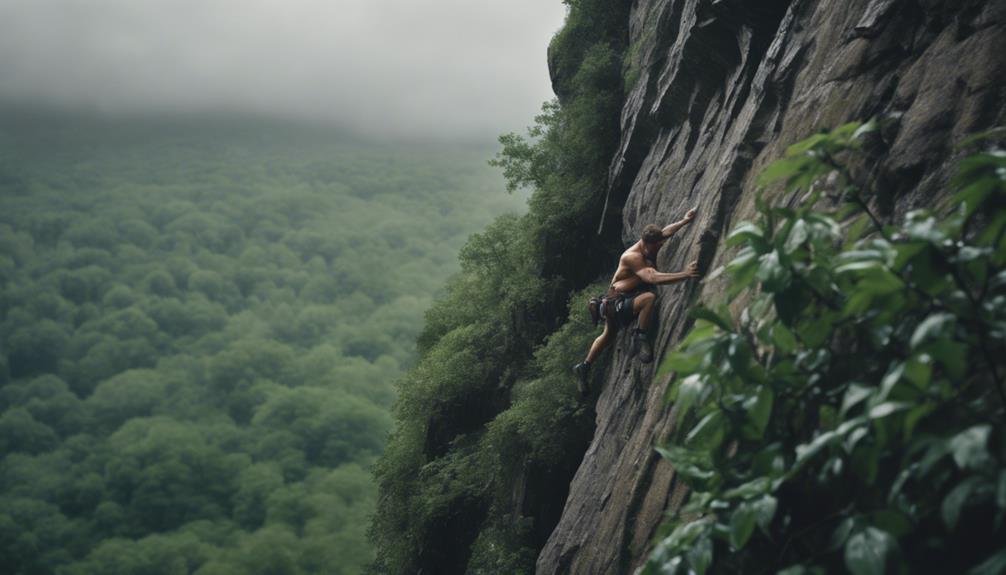
When I think about outdoor climbing, I can't help but consider the challenges that come with it.
Weather can turn a perfect day into a frustrating washout, and getting to remote locations often feels like a trek in itself.
Plus, the inherent risks of climbing outside add a layer of anxiety that I don't always experience in a gym.
Weather Dependency Issues
Climbing outdoors often hinges on unpredictable weather conditions, making it a gamble for enthusiasts like me who crave the thrill of scaling natural rock formations. One moment, the sun's shining, and I'm ready to conquer the crag; the next, dark clouds roll in, and I'm left scrambling for shelter. The elements can turn a perfect day into a soggy nightmare, and that's a risk I can't always take.
These factors can lead to missed opportunities and frustration. While I love the freedom of outdoor climbing, I can't ignore the reality that the weather often dictates my adventures, leaving me yearning for that perfect day when everything aligns just right.
- Rain-soaked rock faces that transform into slippery hazards.
- Chilly winds that bite through my layers, testing my clothing limitations.
- Seasonal variations that dictate when I can climb—snow can ground me for months.
Travel and Accessibility
Traveling to outdoor climbing locations often feels like an expedition, requiring careful planning and sometimes hours of driving just to reach the crag. I've often found myself packed into a car with climbing gear stacked to the ceiling, anticipating the thrill of conquering new heights.
However, this journey can be a double-edged sword. Many stunning cliffs are tucked away in remote areas, limiting transportation options. If you're without a reliable vehicle, your climbing dreams might feel out of reach.
Unlike indoor gyms, where you can simply hop on public transit or bike over, outdoor spots often lack nearby amenities like food, restrooms, or even parking. I've faced the frustration of arriving at a pristine location only to discover I'm miles away from the nearest convenience store or restroom, forcing me to pack everything I'd need for the day.
With such limited accessibility, I've learned that outdoor climbing can be as much about the journey as the destination. While the freedom of nature calls to me, the logistics can sometimes dampen the excitement of scaling those majestic rocks. It's essential to weigh the thrill of adventure against the challenges of getting there.
Safety and Risk Factors
While the thrill of reaching a remote crag can be exhilarating, the inherent safety risks of outdoor climbing often loom larger than those found in the controlled environment of an indoor gym. When I think about climbing outside, I can't ignore the potential dangers that can arise.
Effective equipment selection is crucial. A single faulty carabiner or worn rope can spell disaster. In addition to gear, I need to have solid risk mitigation strategies in place. The unpredictability of nature can throw a wrench into my plans, making it vital to be prepared for anything.
Consider the risks I might face:
- Loose rock that could come crashing down at any moment.
- Weather changes that can turn a sunny day into a stormy nightmare.
- Wildlife encounters that could lead to unexpected injuries.
These factors remind me that while the call of the wild is strong, I must respect the dangers that come with it. Balancing adventure with safety is essential for truly enjoying the freedom of outdoor climbing.
Skill Level Considerations
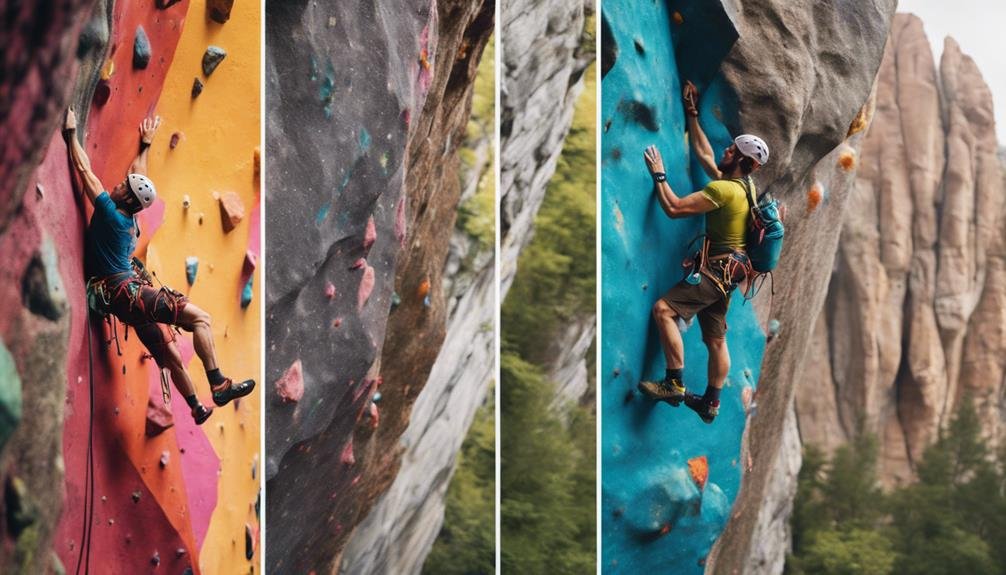
As I navigate the world of climbing, I quickly realize that skill level significantly influences my choice between indoor gyms and outdoor routes.
Indoor climbing gyms offer controlled environments perfect for honing my skills. They provide a variety of routes that challenge my grip strength development and allow for targeted muscle group engagement. I can focus on specific techniques without the unpredictability of the outdoors.
On the other hand, outdoor climbing pushes me to adapt to natural rock formations, which can be thrilling yet daunting. As my skills progress, I find that outdoor routes bring a sense of freedom and adventure that indoor climbing sometimes lacks.
However, I must acknowledge my current abilities. If I'm still mastering the fundamentals, I may feel more comfortable in a gym where I can take my time and build confidence.
Ultimately, it's about finding the right balance. Whether I'm scaling a wall indoors or tackling a boulder outside, I recognize that my skill level shapes my experience. Each setting presents unique opportunities to grow, and that's what keeps me coming back for more.
Equipment and Preparation
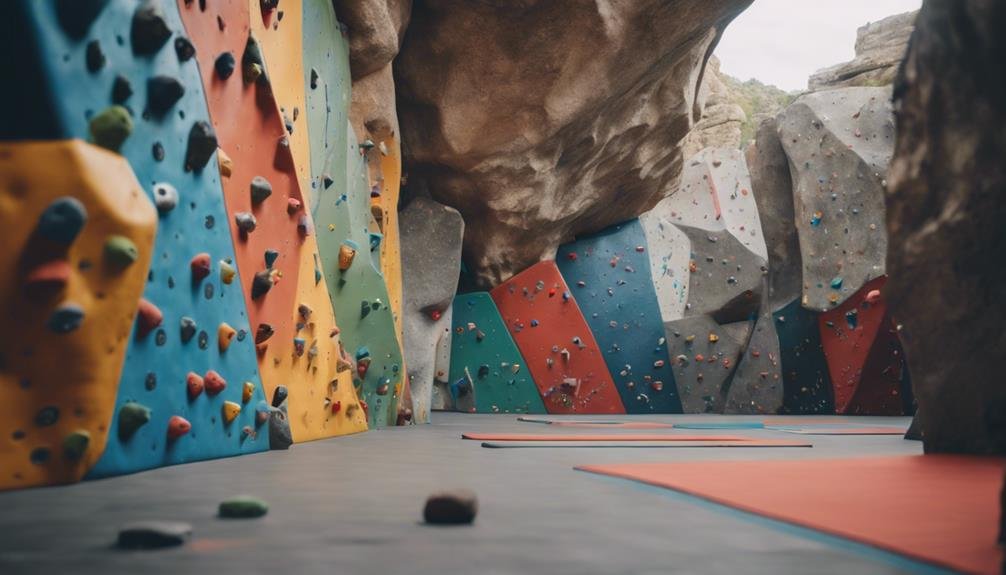
Building on my skill level, I quickly realize that the equipment I choose and the preparation I undertake play pivotal roles in my climbing adventures, whether indoors or outdoors. The right gear not only enhances my performance but also ensures my safety. I've learned that durability is key when selecting climbing gear.
When I prepare for a climb, I focus on:
- Climbing shoes: They should fit snugly, providing optimal grip.
- Harness: A well-fitted harness distributes weight evenly, making long climbs more comfortable.
- Chalk bag: Essential for keeping my hands dry and maintaining grip.
Whether I'm scaling an indoor wall or tackling a rugged outdoor route, my clothing must allow freedom of movement and breathability. I typically choose moisture-wicking fabrics that offer warmth yet remain lightweight. Each piece of gear plays a crucial role in my climbing experience, and I can't underestimate the importance of preparation. By thoughtfully selecting my equipment and clothing, I'm ready to embrace the freedom and challenges that climbing presents, pushing my limits both indoors and out.
Cost Comparison

When I compare the costs of indoor climbing gyms to outdoor climbing, I quickly discover that each option comes with its own unique financial considerations and investments.
Indoor climbing gyms require facility costs that can add up over time. Membership pricing varies widely, often ranging from monthly fees to annual passes, which can be a significant commitment for some. However, this investment grants me access to a controlled environment, expert instruction, and a variety of climbing routes year-round.
On the flip side, outdoor climbing can seem more cost-effective at first glance. I only need basic gear, like shoes and a harness, and I'm free to explore nature's playground. Yet, I must consider additional expenses like travel, parking, and potential gear replacements, especially when tackling more challenging routes.
Ultimately, the financial landscape of climbing can shape my experience, whether I choose the structured convenience of a gym or the wild allure of the great outdoors. By weighing these costs, I can make a decision that aligns with my passion for climbing and my budget, ensuring I enjoy every climb without financial strain.
Personal Preferences and Goals
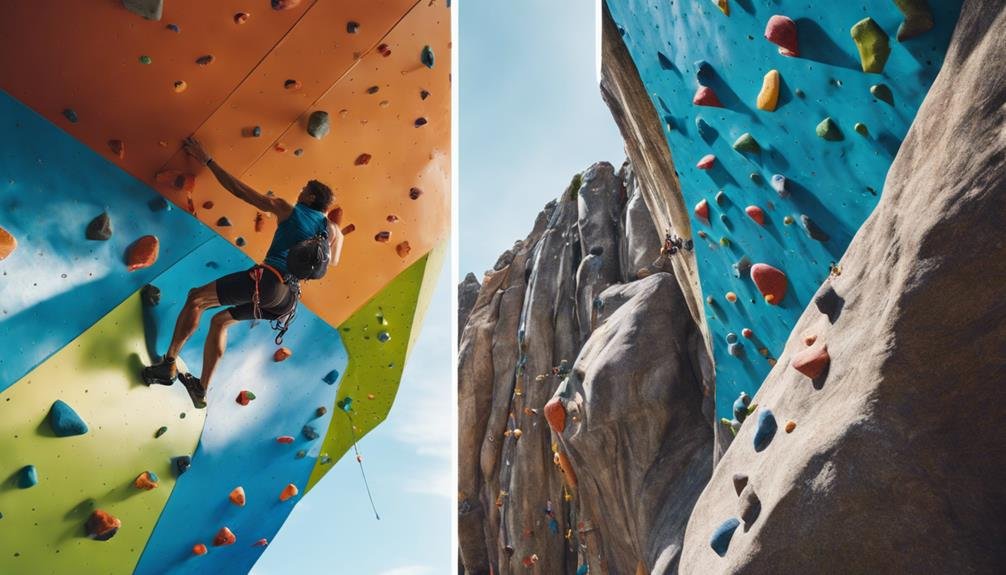
Choosing between indoor climbing gyms and outdoor climbing often hinges on my personal preferences and goals, as each setting offers distinct experiences that cater to different aspirations. My fitness level and climbing experience play a crucial role in shaping my choice.
When I weigh my options, I often envision the following:
- The controlled environment of a gym, with routes tailored to my skill level.
- The thrill of scaling natural rock faces, surrounded by the beauty of the great outdoors.
- The camaraderie of fellow climbers, whether in a bustling gym or on a serene cliffside.
If I'm working on specific techniques or training hard, indoor gyms provide the consistency I crave. However, when I seek freedom and adventure, nothing compares to the raw, exhilarating experience of outdoor climbing. Ultimately, it's about what inspires me most in my climbing journey. Balancing these elements helps me choose the right environment, aligning my climbing adventures with my personal goals and desired experiences.
Conclusion
In the end, choosing between indoor and outdoor climbing really depends on what excites you.
Did you know that about 70% of climbers prefer the thrill of scaling natural rock? That rush of fresh air and the sound of rustling leaves can't be replicated indoors.
Whether I'm navigating a vibrant gym wall or conquering a rugged cliff, each experience shapes my skills and passions uniquely.
So, go explore both worlds, and see where your heart takes you!
